Galapagos Islands, Ecuador
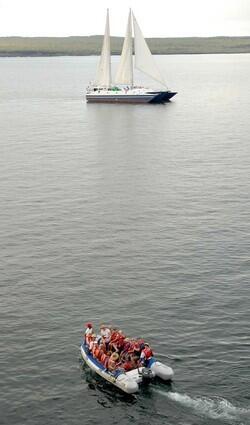
Tourists travel back to their yacht from one of the Galapagos Islands. People come for a close-up look at giant tortoises, blue-footed boobies and other unusual species. (Steve Stroud / Los Angeles Times)
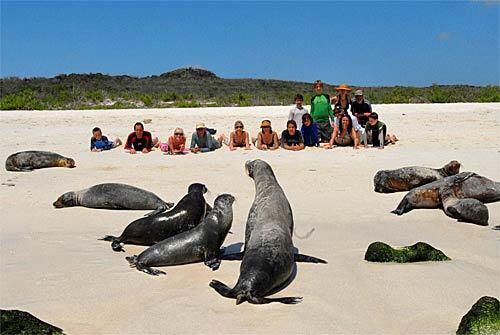
Curious tourists, all in a row. Six hundred miles west of Ecuador, visitors to the Galápagos island of Española strike a pose for a group of sunbathing sea lions. Charles Darwin may have drawn attention to the islands in the 19th century with his theory of evolution, but those who come here may tell you that their true draw is the wonders that occur when nature is allowed to thrive unspoiled. (Robert Grimstone / For The Times)
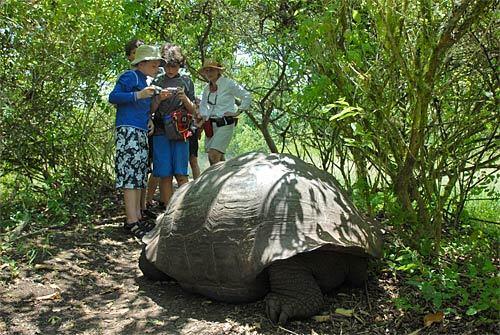
Yep, that’s the one: Young visitors Jack Newton (left) and Charlie Hall compare digital photos of their nearby subject, a giant Galápagos tortoise, on Santa Cruz Island. There’s no better place than Santa Cruz to check out the enormous tortoises. The tortoises can live up to 200 years. (Steve Stroud / Los Angeles Times)
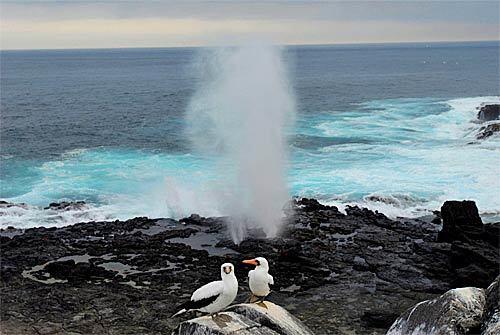
A pair of Nazca bobby birds share a rock near a blowhole on Española Island. The orange-billed seabirds are native to islands along the Nazca tectonic plate, primarily the Galápagos. And they’re not to be confused with the masked booby, which features a yellow bill. (Steve Stroud / Los Angeles Times)
Advertisement
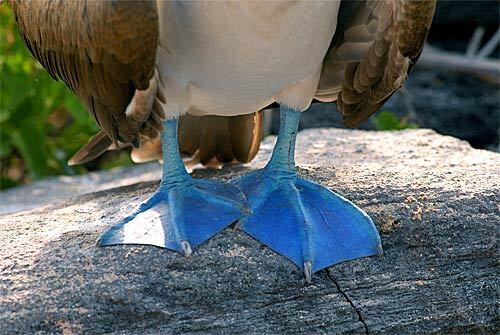
A blue-footed booby shows off its aptly named tootsies in the Galápagos. When trying to woo potential mates, the birds let fly with the fancy footwork. (Steve Stroud / Los Angeles Times)
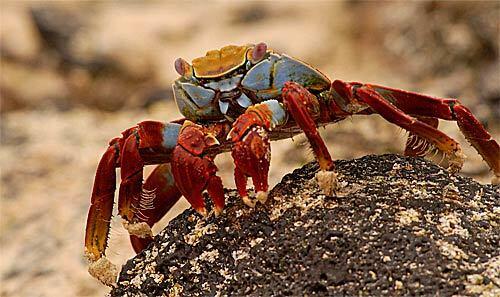
A Sally Lightfoot crab assumes a defensive position on a beach on Española Island. The brightly colored crabs can get out of harm’s way quickly, hence the term “lightfoot.” (Steve Stroud / Los Angeles Times)
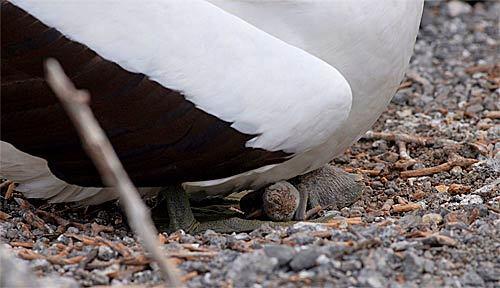
A Nazca booby chick is warmed and protected by its parent on Genovesa Island. Although its nickname is Hitchcock Island (a nod to the film “The Birds”), Genovesa seems more like the Island of Love. This is where courtship is constant and babies are turned out with production-line speed. (Steve Stroud / Los Angeles Times)
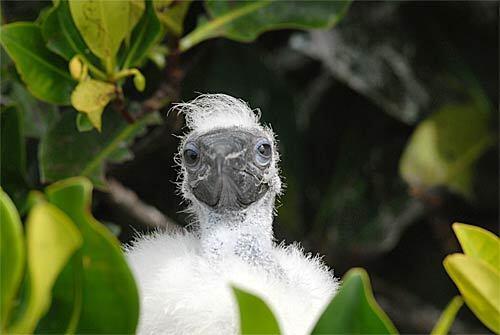
Are you my mother? A red-footed booby chick peeks from its nest on Genovesa in the Galápagos Islands, where evolution runs wild. Genovesa is also the only place an eco-tourist can be assured of spotting the red-footed booby. (Steve Stroud / Los Angeles Times)
Advertisement
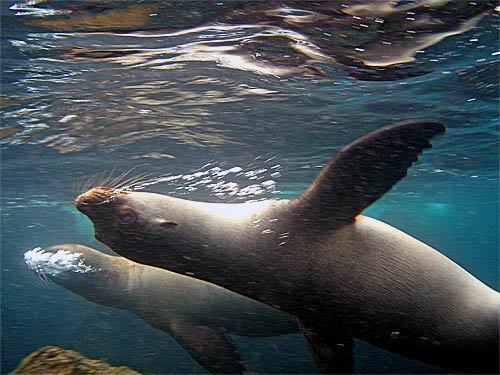
Sea lions frolic off San Cristóbal Island. A close-up encounter reveals that they have no fear of humans. That could change, however: UNESCO has declared the Galápagos Islands “in danger” because of increased development and tourism. And Ecuador is considering restricting not only tourist permits and flights to the islands but also residency permits. (Steve Stroud / Los Angeles Times)
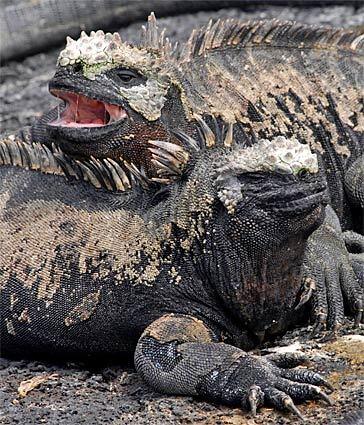
A pair of marine iguanas keep each other warm on Fernandina Island before taking a dip in the Pacific Ocean. Darwin’s evolutionary theory is at work here: It’s theorized that a long drought on these islands forced the land iguana to the water to find food. Thousands of years later, this adaptation has made the marine iguana look and act different from the land reptile that occupies most of these islands. (Steve Stroud / Los Angeles Times)
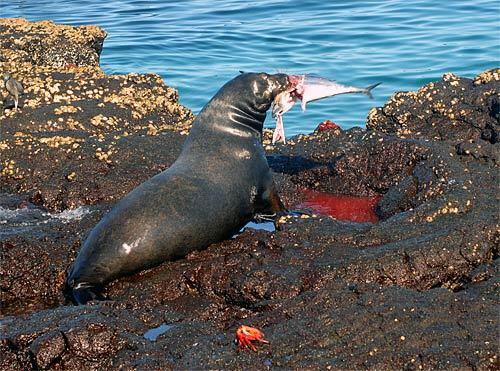
Blood from a freshly caught tuna fills a tidal pool on the craggy lava shore as a sea lion consumes the fish on Fernandina. A group of eco-tourists witnesses the feeding frenzy. First the sea lion takes its share, followed by white-tipped sharks, looking for a piece of the action. The sharks move in to claim their share, followed by frigate birds, then the marine iguanas and, finally, the crabs. (Steve Stroud / Los Angeles Times)
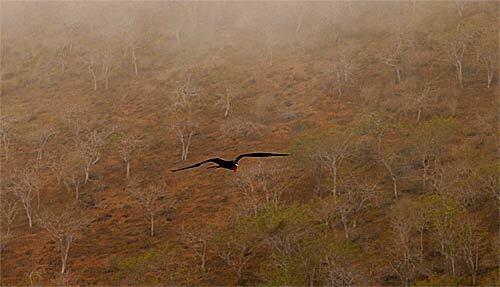
A male frigate bird navigates through a light fog above Floreana Island. Floreana is one of the many islands in the chain offering eye-popping sights, including a simultaneous sunset-moonrise and a pod of orca whales that cozied up to eco-tourists’ boat one evening. (Steve Stroud / Los Angeles Times)
Advertisement
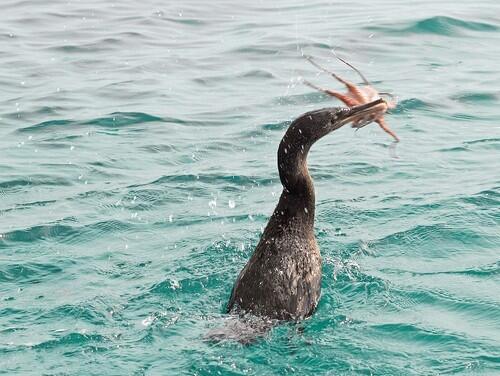
A flightless cormorant, a species found only in the Galápagos Islands, plucks an octopus from the waters off Isabela Island. The bird then twirled it around until it was positioned just right and took a big gulp. (Steve Stroud / Los Angeles Times)
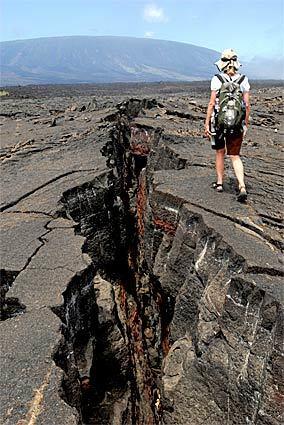
Caution: fissures ahead. Fernandina, the youngest of the Galápagos Islands, is rent by a giant volcanic vent. The island is home to marine iguanas, one of evolution’s grand experiments. Hundreds of them. (Steve Stroud / Los Angeles Times)
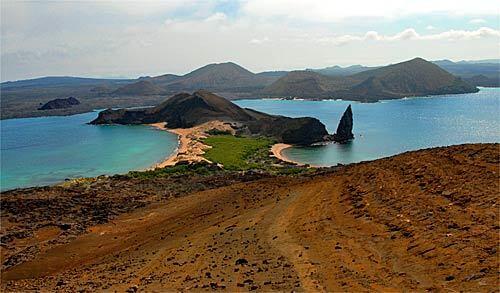
The view from Bartholome Island is not especially overwhelming, the terrain dusty and brown. Where is all the lush greenery and swaying palm trees that one would expect in a tropical archipelago? Don’t be fooled, however. It is a paradise -- one of fascinating creatures that evolved to fit their habitats. (Steve Stroud / Los Angeles Times)



